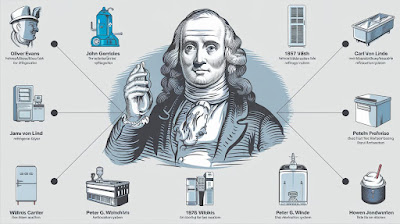Refrigeration is a technology that has revolutionized the way we live, directly impacting areas such as food preservation, medicine and domestic comfort. Over the centuries, refrigeration systems have evolved significantly, from rudimentary cooling methods to the modern and efficient technologies we know today. Understanding this evolution allows us to value technological progress and appreciate the complexity of the refrigeration systems we use daily.
1. The beginnings of refrigeration:
Before the development of modern technologies, ancient civilizations used natural methods to preserve food and keep environments cool. In Ancient Egypt and Mesopotamia, for example, storage techniques were used in caves and buried ceramic pots to take advantage of the coolness of the soil. In China, there are records of storing ice and snow collected during the winter to be used in the warmer seasons. These rudimentary methods, although effective for the time, had their limitations, as they depended on local climate conditions.
2. Innovations in the 19th century:
The 19th century marked a significant turning point for refrigeration with the invention of the first refrigeration machines. In 1834, Jacob Perkins developed the first vapor-compression refrigeration machine, which used ether as a refrigerant. Shortly thereafter, in 1851, James Harrison introduced a commercial version of Perkins’s machine, which was used in brewing and food preservation. These innovations paved the way for large-scale refrigeration and the creation of industries that depended directly on this technology.
3. The era of domestic refrigerators:
In the early 20th century, refrigeration began to make its way into the home. The introduction of domestic refrigerators in the 1920s revolutionized everyday life, allowing food to be preserved for longer periods and creating a new market for frozen foods. The popularization of these appliances was facilitated by the replacement of dangerous ammonia and sulfur dioxide gases with safer refrigerants such as freon, although the latter was later identified as harmful to the ozone layer, leading to its replacement by more environmentally friendly options.
The history of refrigeration systems reflects a continuous journey of innovation and adaptation to human needs. From the natural methods used by ancient civilizations to the complex modern systems that ensure food freshness and thermal comfort, the evolution of refrigeration demonstrates how the search for technological solutions profoundly impacts our daily lives. As we move forward, the focus on sustainability and energy efficiency will continue to shape the future of refrigeration, ensuring that this vital technology becomes increasingly efficient and environmentally friendly.
